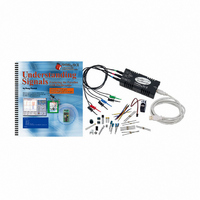28119 Parallax Inc, 28119 Datasheet - Page 57

28119
Manufacturer Part Number
28119
Description
KIT UNDERSTANDING SIGNALS
Manufacturer
Parallax Inc
Datasheet
1.28119.pdf
(137 pages)
Specifications of 28119
Lead Free Status
Contains lead
Accessory Type
Oscilloscope
Interface Type
USB
For Use With/related Products
BASIC Stamp® 2 and Board of Education
Lead Free Status / Rohs Status
Lead free / RoHS Compliant
Available stocks
Company
Part Number
Manufacturer
Quantity
Price
Company:
Part Number:
281197-2
Manufacturer:
TE
Quantity:
20 000
Company:
Part Number:
281197-2
Manufacturer:
MOLEX
Quantity:
2 500
Chapter 4: R/C Circuits and Variable Resistors · Page 49
Chapter 4: R/C Circuits and Variable Resistors
Resistors and capacitors are integral to analog electronics. Anything you do with analog
electronics will involve resistors and capacitors. Understanding how they react with each
other is important. This chapter will demonstrate how to use the OPTAscope to view
charge and discharge curves of capacitor and resistor networks.
WHAT ARE CAPACITORS?
Capacitors have two main behaviors in electronic circuits: charging and discharging.
When a voltage is applied to a capacitor, the capacitor charges. When the charge in the
capacitor equals the voltage applied, the capacitor stops charging. The charge will remain
in the capacitor with or without the voltage applied to the capacitor.
The capacitor will discharge when a path for current to flow through is placed across the
capacitor. The capacitor will discharge until the charge across the capacitor is completely
dissipated, thereby equaling zero volts. A capacitor can repeat this charge and discharge
cycle without the “wear and tear” that a battery would endure. Think of a capacitor as a
temporary power source that is charged by applied voltage, and then can supply voltage
back into the circuit when the applied voltage sinks or disappears.
RESISTORS AND CAPACITORS IN RC NETWORKS
A resistor will resist the flow of current. The larger the value of the resistor, the more it
will resist current flow. Capacitors charge and discharge very quickly. By placing a
resistor in series with a capacitor you can precisely control the rate at which a capacitor
will charge or discharge. This is called an RC network or RC circuit.
By controlling the amount of capacitance and resistance, you can control the charge and
discharge rate, or “curve”, of the RC network. The higher the values of the capacitor and
resistor, the longer the time it will take for the capacitor to charge. We can calculate how
long the charge and discharge curve will be by calculating the time constant. Here is the
formula:
=
Time
Constant
R
x
C





















